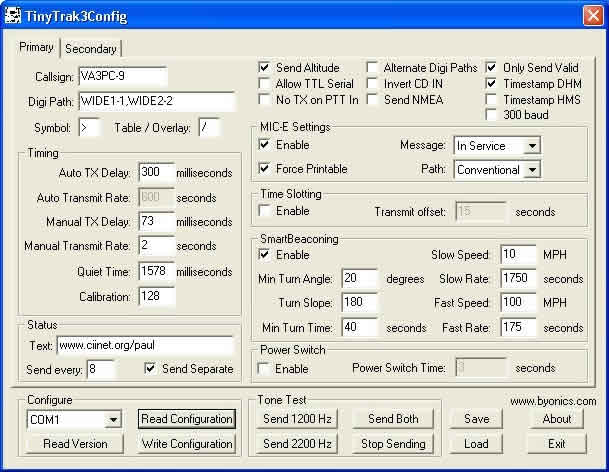| Home Page > My Mobile Station > APRS Settings | Updated:
2018-01-27
|
VA3PC's APRS Settings
OVERVIEW: APRS is not just a vehicle tracking system (GPS was added in the 1992 time frame when GPS became affordable). APRS is much more. APRS is used to provide situational awareness to all operators of everything that is going on in the local area, whether it be weather reporting, traveler info, direction finding, objects pointing to ECHOlink and IRLP, or traffic reporting and emergency response. Think of APRS as a signalling channel to reveal ALL amateur radio resources and live activities that are in range of the operator at any instant in time. APRS got it start in 1984 when the connectionless protocol was developed by Bob Bruninga WB4APR.
With that being said, most APRS stations are used for vehicle tracking. New developments over the past few years have really helped with world wide updates and mapping functions.
What are those -N numbers on the end of callsigns you ask?
Here are those common defaults:
-0 Home Station, with messaging
-1, 2, 3, 4 are for digipeaters and other stations
-4 is for HF to VHF Gateway
-5 IGate (Not home station) or other networks
-6 is for Operations via Satellite or Special Activity
-7 is for TH-D7 walkie talkies , HT or other portable operations
-8 is for boats, sailboats and ships, RV's etc.
-9 is for Primary Mobile (message capable)
-10 is for operation via the internet only
-11 is for aircraft (and the occasional Balloon)
-12 Portable trackers (one way) etc
-13 Weather Stations
-14 for Truckers, full time drivers
-15 for HF Gateways
The first APRS position reports were broadcast at regular intervals. The only exception was that if the channel was busy, do not transmit. It was noticed that in areas where there were many units, congestion was making successful decoding of packets problematic. SmartBeaconing™ was invented by Tony Arnerich KD7TA and Steve Bragg KA9MVA in order to reduce the amount of packets required to update a moving object. It works using the following algorithm:
IF (speed < low_speed) {beacon_rate = slow_rate;} // Stopped - slow rate beacon
ELSE // Moving - varies with speed
{ IF (speed > high_speed) {beacon_rate = fast_beacon_rate;} // Fast speed = fast rate beacon
ELSE {beacon_rate = fast_beacon_rate * high_speed / speed;} // Intermediate beacon rate
// Corner pegging - if not stopped
turn_threshold = turn_min + turn_slope / mph; // turn threshold speed-dependent
IF (heading_change_since_beacon > turn_threshold) AND (secs_since_beacon > turn_time)
{secs_since_beacon = beacon_rate;} // transmit beacon now
}
IF ( secs_since_beacon > beacon_rate) {send_beacon} // send beacon and loop
Here are my current settings, and explanation..
I just returned from a trip through Northern Ontario, and observed the beaconing was too frequent, here are my modified parameters to quiet things down a little.
Slow Speed = Speed below which I consider myself "stopped" 10 m.p.h.
Slow Rate = Beacon rate while speed below stopped threshold (1750s = ~29mins)
Fast Speed = Speed that I send out beacons at fast rate 100 m.p.h.
Fast Rate = Beacon rate at fastest interval (175s ~ 3 mins)
Any speed between these limits, the beacon rate is proportional.
Min Turn Time = don't beacon any faster than this interval in a turn (40sec)
Min Turn Angle = Minimum turn angle to consider beaconing. (20 degrees)
Turn Slope = Number when divided by current speed creates an angle that is added to Min Turn Angle to trigger a beacon.
With these settings, I see my corners quite well, and don't beacon too often when moving in a straight line.
There is much more information on APRS, don't hesitate to GOOGLE for more! 73 Paul


